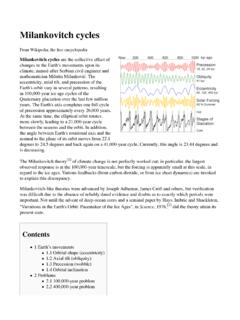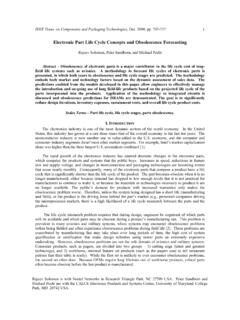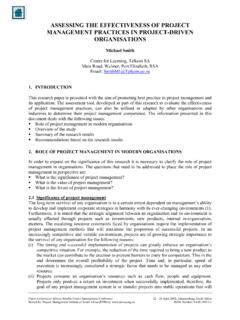Transcription of Interfacing to High Speed ADCs via SPI - Analog Devices
1 AN-877 APPLICATION NOTE One Tech nology Wa y P. O. Box 9106 Norwood, MA 02062-9106, Te l: F ax : w w Inter facing to High Speed ADCs via SPI by the High Speed Converter Division Rev. B | Pag e 1 of 20 INTRODUCTION This application note describes how to use the serial peripheral interface (SPI) port o n Analog D evices, Inc., high Speed co nverters. In addition, this application note defines the electrical, timing, and procedural requirements for Interfacing to these Devices . The im p le mentation is compatible with industry-st andar d SPI ports and employs, at minimum, a 2-wire mode and optional chip select. DEFINITION The SPI port consists of thre e pins: the serial clock pin (SCLK), the serial data input/output pin (SDIO), and the chip select bar pin (CSB).
2 Optionally, some chips may imple ment a se rial data out pin (SD O), which is re fe rred to as 3-wire mode . To minimize pin count, most chips omit this pin. However, if it is include d, it is used only for reading data from the device. CSBSCLKSCLKSDIOSDIOCSBSPICONTROLLERCONVE RTERINTERFACE05739-001 Fi g u re 1. Single Device Control in 2-Wi re M o d e 05739-013 CSB 0 CSB 1 SCLKSCLKSCLKSDIOSDIOSDIOCSBCSBSPICONTROL LERCONVERTERINTERFACEDEVICE 1 CONVERTERINTERFACEDEVICE 2 Fi g u re 2. Multiple Device Control in 2-Wi re M o d e AN-877 Application Note Rev. B | Pag e 2 of 20 TABLE OF CONTENTS Introduction .. 1 D e finition .. 1 Re vision History .. 2 SPI Port Pins .. 3 Se rial Clock (SCLK) .. 3 Serial Data Input/Output (SDIO).. 3 Chip Select Bar (CSB).
3 3 Serial Data Out (SDO) .. 4 F o rma t .. 5 Instruction Phase .. 5 Read/Wr ite .. 5 Wo r d L e n gt h .. 5 Streaming .. 6 Address 6 Detection of SPI Mode and Pin Mode .. 7 Har d wa re Inte rf a cing .. 7 Chip 8 Configuration Register (0X000).. 8 Transfer Register (Master-Slave Latching) (0x0FF) .. 8 Chip ID (0x001).. 9 Chip Grade (0x002) .. 9 Device Indexing (0x004 and 0x005).. 9 Program 10 Pro gra mm ing Example .. 17 C o ntro l R e gis te 18 REVISION HISTORY 4/2017 R e v. A to R e v. B Change CSB 0 to CSB in Figure Changes to Figure 2 ..1 Change to Se rial Clock (SCLK) Se C h a n g e s t o Ta b le 2 Ca p t io n ..6 Changes to Table 3 Caption ..8 C h a n g e s t o Ta b le 4 and Table C h a n g e s t o Ta b le 6 and Table C h a n g e s t o Ta b le 8.
4 12 C h anges to Ta b le 9 ..13 Changes to Table 10 and Table C h a n g e s t o Ta b le 1 2 ..15 C h a n g e s t o Ta b le 1 3 ..16 Change to Programming Example C h a n g e s t o Ta b le 1 4 ..18 4/2007 Initial Version to Rev. A U pd at e d Fo rm a Unive rsal Changes to Transfer Re gister Se Changes to Figure 13 ..10 Added Table 6 ..11 Adde d PLL Control (0x00A) Se ction ..11 C h a n g e s t o Ta b le 8 ..12 12/2005 Revision 0: Initial Version Application Note AN-877 Rev. B | Pag e 3 of 20 SPI PORT PINS The following sections described the SPI port pins. Caution: Re fe r to spe cific Analog -to-digital conve rter (ADC) data sheets to determine the nominal and absolute maximum logic voltages. SERIAL CLOCK (SCLK) The SCLK pin is the se rial shift clock in pin.
5 This pin is imple me nted with a Schmitt trigger, to minimize sensitivity to noise on the clock line, and it is pulled low by a nominal 50 k resistor to ground. This pin may stall either high or low. SCLK is used to synchronize serial interface reads and writes. Input data is registered on the rising e dge of this clock and output data transmissions are registered on the falling edge. Unless otherwise specified, the maximum clock Speed of the ADC SPI port is 25 MHz. See the spe cific product data s h e et for more information pe rtaining to SPI speeds supported for a particular de vice. The typical hold time (tDH) is 0 ns, and a minimum setup time (tDS) of 5 ns is required between SCLK and SDIO. (See the specific device data sheet to determine the e xact inte rface timing re quire me nts.)
6 To optimize internal and external timing, the bus is capable of turning around the state of the SDIO line in half an SCLK cycle . This means that, after the address information is passed to the converter requesting a read, the SDIO line is transitioned from an input to an output within one half of a clock cycle . This ensures that by the time the falling edge of the next clock cycle occurs, data can be safely place d o n this serial line for the controller to read. If the e xternal controller is insufficiently fast to keep up with the ADC SPI port, the external device can stall the clock line to add additional time allowing for e xte rnal timing issue s. SERIAL DATA INPUT/OUTPUT (SDIO) The SD IO pin is a dual-purpose pin. The typical role for this pin is as either an input or an output, depending on the instruction be ing se nt (read or write) and the relative position (instruction or data phase) in the timing frame.
7 During the first phase of a write or a read, this pin functions as an input that passes information to the internal state machine. If the command is determined to be a read command, the state machine changes this pin (SDIO) to an output, which then passes data back to the controller. (See tEN_ SDIO and tDIS_ SDIO in Ta b le 1.) If the de vice includes an SDO pin and the configuration register is set to take advantage of it, the SDO becomes active instead of the SDIO pin changing to an output. At all other times, the SD O pin re mains in a high impedance state. If the command is determined to be a write command, the SDIO pin remains an input for the duration of the instruction. CHIP SELECT BAR (CSB) CSB is an active low control that gates the read and write cycles.
8 There are several modes in which the CSB can be operated. For situations where the controller has a chip select output or other means of selecting multiple Devices , this pin can be tied to the CSB line. When this line is low, the device is selected and infor-mation on the SCLK and SD IO line s is proce sse d. If this pin is high, the device ignores any information on the SCLK and SDIO lines. In this manner, multiple Devices can be connected to the SPI port. In cases where only one device is connected, the CSB line can be optionally tied low and the device is perma-nently enabled. (Tying the CSB line low excludes the possibility of resetting the device if an error occurs on the port.) The CSB line can also be tied high to enable secondary function of the SPI port.
9 (See the Detection of SPI Mode and Pin Mode se ction for more de tails.) CSB is a high impe dance line , pulle d high by a nominal 50 k re sistor. CSB may stall high, that is, remain high for multiple clock cycles (see Figure 5) in some configurations to allow for additional external timing. If three or fewer words (not counting instruction information) are being transmitted through the interface at a time, CSB may stall high between bytes, including the bytes of the instruction information. If CSB stalls high in the middle of a byte, the state machine is reset and the controller returns to the idle state, awaiting the transmission of a new instruction. This mechanism allows restoration after a fault has been detected. To detect the reset, at least one and no more than seven serial clocks must occur.
10 Once the state machine has entered the idle state, the next falling edge of the CSB initiates a new transmission cycle . Some Devices implement secondary functions with the SPI pins. Typically, these functions include output data format, duty cycle stabilizer, or other common features. These pin functions are enabled by the CSB pin. If the CSB pin is tied high, the SPI functions are placed in a high impedance mode. In this mode, secondary functions are then turned on, allowing control of features on-chip, without requiring the SPI to operate. These features vary by device. Therefore, the individual device data sheet must be consulted to determine if this feature is supported and what it controls. For applications to be controlled by the SPI port, the secondary function takes priority until the device has be en acce sse d b y the SPI port.
















